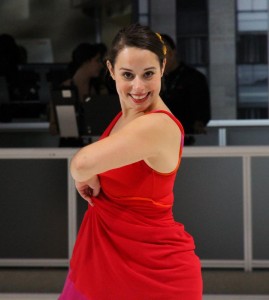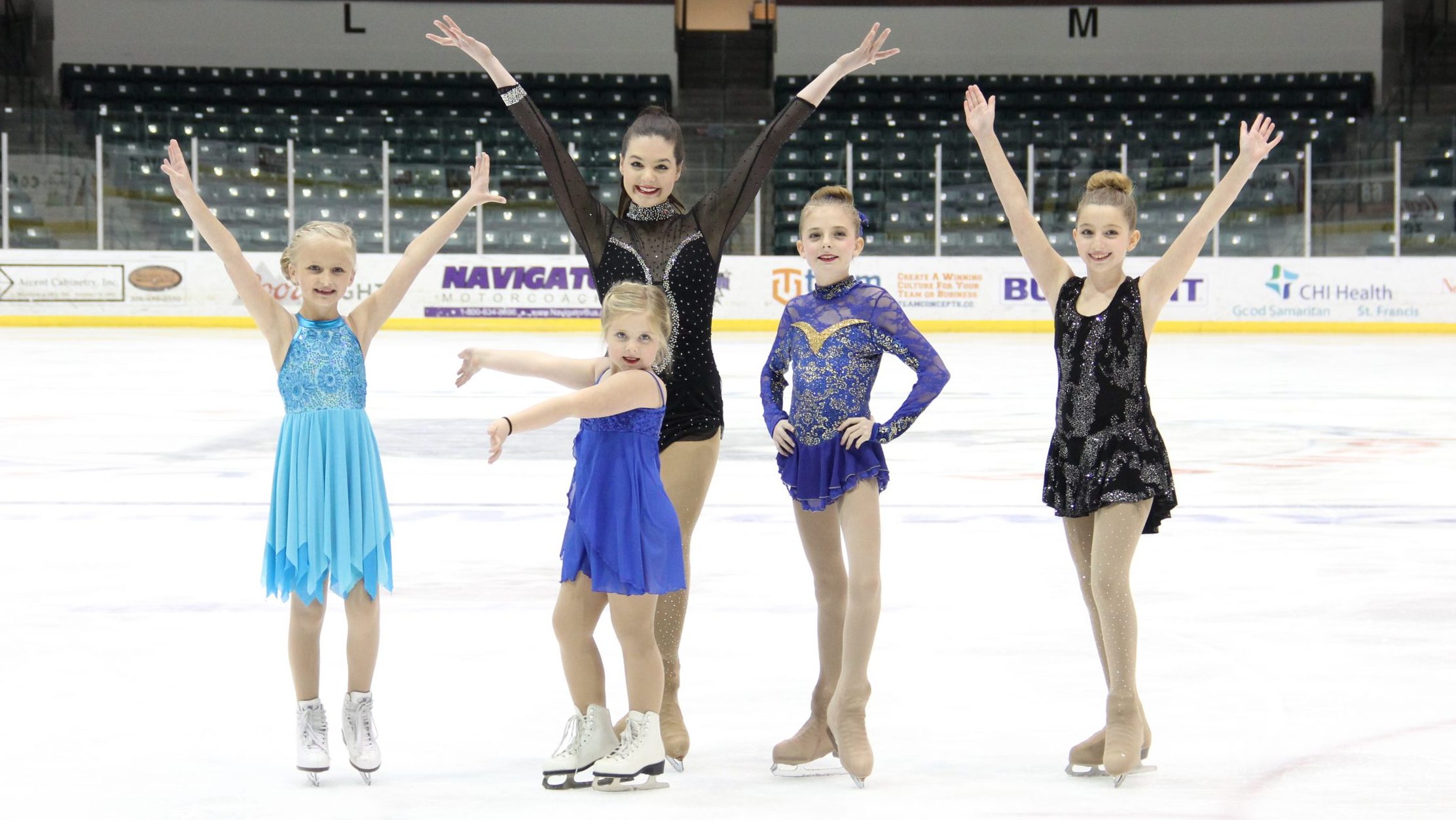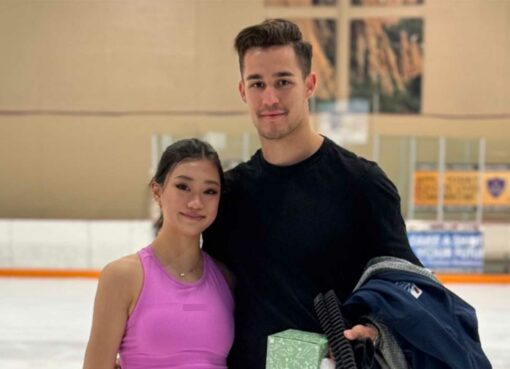By Jamie M. Blanchard
Figure Skaters Online
__________
 Even if you have never heard of Kate McSwain, you might have already enjoyed her work. She’s choreographed for skaters including two-time U.S. Champion Jeremy Abbott, who used her program on the special Skate for the Heart, set to air later this month on NBC, and World Junior Pairs Champion Drew Meekins.
Even if you have never heard of Kate McSwain, you might have already enjoyed her work. She’s choreographed for skaters including two-time U.S. Champion Jeremy Abbott, who used her program on the special Skate for the Heart, set to air later this month on NBC, and World Junior Pairs Champion Drew Meekins.
The budding choreographer is no stranger to skating, having competed for 10 years, reaching the senior level, before branching out to artistic competitions. Last year, she performed in one of Karen Kresge’s summer ice shows and participated in performance event with Ice Theatre of New York.
“I began skating at age 10 in my hometown of Lexington, Kentucky, but quickly moved to train at the Detroit Skating Club with Allen Schramm and his wife, Angela (Greenhow) for three years,” she said. I followed them when they relocated to Dallas-Ft. Worth and trained there for a year and a half, making seventh place in junior ladies at Sectionals in 2004, with two programs I choreographed for myself.”
“Then, I moved to train with Tom Zakrajsek and Tom Dickson at the Broadmoor Skating Club in Colorado Springs, competing one last season in senior,” she said. “Since then, I have continued to train and choreograph, sharpening my skills for ice shows and artistic competitions.”
In the 2009 National Showcase, she won the senior dramatic event and placed second overall.
“I performed one of my favorite pieces, ‘Tango de Roxanne’, from the movie Moulin Rouge. I did the choreography myself and felt that I skated really well. The competition itself was really fun too, with spotlights and a great audience,” McSwain said. “I was on a contract and couldn’t participate in the 2010 competition, but am hoping to participate in National Showcase 2011 next summer.”
McSwain recently sat down with Figure Skaters Online to talk choreography, including her new project, Sk8tivity clinics, which she started to help skaters of all levels cultivate the skills need to perform at their highest artistic potential.
How did you get your start in choreography? I dabbled in movement and composition as far back as age 12 when I was still living in Kentucky, helping touch up programs of fellow skaters such as Ameena Sheikh. I’ve known ever since that I wanted to pursue skating choreography as a career. I have been seriously choreographing programs since I was 16. That year, Allen challenged me to choreograph my long and short junior programs, and so I did. I quickly found that I enjoyed it, and did those as well as several show programs that year.
You were a finalist in the “Grassroots to Champions: Young Artists Showcase” international figure skating choreography competition. The YAS (Young Artists Showcase) competition was one of the best experiences in my career thus far. I enjoyed it immensely, and learned so much from each challenge, from my competitors and my performing skaters, and from the judges’ responses. First of all, I learned how subjective choreography really is. Every judge had a very different opinion about each of our works and it was incredibly interesting to hear each perspective. I also learned that I should really trust in my instincts and abilities. The challenges were invigorating and exciting; I loved working under the time gun to see how efficient I could be with my movement for each piece. I also loved the freedom that the challenges gave us — we could skate to music we were truly passionate about and we didn’t have to worry about a technical mark. YAS offered me so many opportunities and doorways I could never have imagined and it definitely sparked an even deeper passion inside me for what I’ve always wanted to do.
Where does the inspiration for your choreography come from? Most of my choreography is very musical and emotion-based. The process in which I choreograph usually begins when I hear an inspiring piece of music. I listen to it a few times, creating a list of words describing how it moves me and what types of emotions and adjectives I can draw from it, and then I use my body to begin to express literally the notes and words I identified. Oftentimes, the words I list come together to create a story or a character, but sometimes, depending on the music, my entire composition is created from one or two simple emotions.
Who are some of the choreographers that you look up to? Overall, I owe a lot of my skating artistry skills, style, and soul to Allen and Angela Schramm. My two choreography idols are Lori Nichol and David Wilson. Even with such longevity, Lori still continues to create beautiful work. And in my opinion, David is a master at creating pieces that really suit the skater. I believe that when a program is finished, it should look like the skater’s piece, not the choreographer’s and I think David has perfected that. I can’t finish this answer without mentioning Jeff Buttle and Shae-Lynn Bourne, too, who both also have incredible artistic spirits and movement that really set them apart.
A couple of those choreographers have worked with two-time U.S. Champion Jeremy Abbott, someone who you recently worked with on a program for Skate for the Heart. That program was such a blast to choreograph for him! He asked me to do it this summer after we worked together on the third challenge of YAS, called “Return to the Classics.” Jeremy and I have been best friends for awhile, but we’ve always really connected artistically too, and I think he enjoyed working with me on both pieces. The music for Skate for the Heart was assigned to us from Lea Ann Miller, another wonderful choreographer, and normally, I like to go through the artistic process with a skater. But with Jeremy’s international season approaching, we were tight on time, so I worked with it on my own for quite a while, without his input. I had to list out my adjectives, words and emotions behind the notes and feel as though the movement was organically created from those emotions before I felt ready to share it with him. After we worked on it and I described each emotional thought, I think it artistically challenged him—in a good way.
What was it like seeing that program come to life under all of the lights and with all of the television cameras? It was the coolest feeling in the world. I got to actually be at the event, sitting in the audience, and I was really, really nervous, as if I was going to skate it myself. I didn’t expect that. As he skated, I remembered each part we had spent a lot of time on, and I felt like I could laugh and cry at the same time. I felt like a part of the piece was mine, but it was all in his hands—or body actually. I seriously have never had a feeling like that but it was amazing. I hope to more experiences like that in the future.
Skate for the Heart is set to air January 16 on NBC. Do you have any special plans to watch it? I will certainly watch it with friends and family, and Tweet about it. I’ll probably get nervous again too.
You recently launched Sk8tivity. Sk8tivity teaches figure skaters at all levels the value, freedom, and passion they can discover in artistic, emotional, and theatrical concepts within their own bodies on the ice. I want to help skaters adapt to the IJS [international judging system] component score requirements and advance a greater understanding of, and appreciation for, artistry in the sport. I also want skaters to see that skating is an art and that a connection with the audiences and/or the judges is essential for them to perform at their highest potential.
Where did the idea come from? I came up with the idea for Sk8tivity last year after Tom Z. approached me about offering artistic workshops for his students. In a clinic, I help skaters learn to “think outside the box” and bring a different quality to the artistry in their programs, drawing from concepts in several areas of performance such as dance, theater, choreography, improvisation, and music.
When can we get in on a Sk8tivity clinic? The next two Sk8tivity clinics for which I have dates set are in Kentucky. However, I will be doing some supplementary clinics along with Audrey Weisiger’s “Grassroots for Champions” series next spring or summer. We’re currently working on getting the dates and locations set for that. I’m hoping to return to Colorado Springs and work with Tom Z.’s kids again as well for the next season.
And there not just any group of Tom Z.’s kids. You’ve directed artistic seminars for his top competitive skaters, including Rachael Flatt, Brandon Mroz, Ryan Bradley, Agnes Zawadzki and Joshua Farris. What was it like to work with such an esteemed group? Every one of those skaters is focused, disciplined, and ready to learn. It was a wonderful group to work with because they were so receptive to my ideas and my out-of-the-box exercises. I tend to be an intense choreographer and teacher, so one of the best parts of working with these students was feeling their energy and intensity given right back to me! They were excited about my thoughts and willing to try some new, off-the-wall things to understand creativity in movement. It’s always a blessing for a choreographer to have skaters with open minds and energetic spirits when you’re teaching them concepts that are freeing even if they seem to be uncomfortable at first.
Who are some of the other skaters that you’ve worked with? In addition to Jeremy Abbott, I’ve had the opportunity to closely work with Drew Meekins, Marissa Secundy, Alex Johnson, Erin Reed, and upcoming junior nationals competitor Jessica Tran. Alexe Gilles and Italy’s Paul Parkinson also participated in my artistic clinics. In addition, I am choreographing the programs for several of Nick LaRoche’s higher level students for this upcoming competitive season.
Who are some of your dream skaters to choreograph for? I would love to work with Daisuke Takahashi and I would love to do a pair number for Caitlin Yankowskas and John Coughlin. As for retired skaters, the ones I think I could connect with and I would dream to work with are Michelle Kwan, Joannie Rochette, and Jeff Buttle. All of these skaters really have something inside them ready to give to an audience, and one of my favorite parts about choreography is having the chance to set a program full of emotion on them, so they have an outlet to give that soul in performance.
Do you have a favorite program that you’ve choreographed? My favorite program of all time would probably be a show program I choreographed for myself at age 16 to Barbara Streisand’s “Papa, Can You Hear Me?” I have performed it over 10 times in my career for a number of audiences, and every time I do, I feel a renewed energy, passion, or emotion inside that I need to share with my audience in that moment.
What’s next for you Kate? I plan to move to Boston within the next two years and begin choreographing from there, but still traveling during the season to present my Sk8tivity clinics across the nation. It is my dream to be a choreographer for Olympic-level skaters and to bring back a sense of individuality, emotional connection, and movement that pushes the limits within competitive programs we see in the judging system today.
For more information on Kate McSwain, visit www.kmcswain.com.
[nggallery id=5]
__________
Photos courtesy of Kate McSwain
Figure Skaters Online strives to be an accurate source of information related to the sport of figure skating. To report an error, please e-mail the news editor. Include the article date and title in your e-mail.




